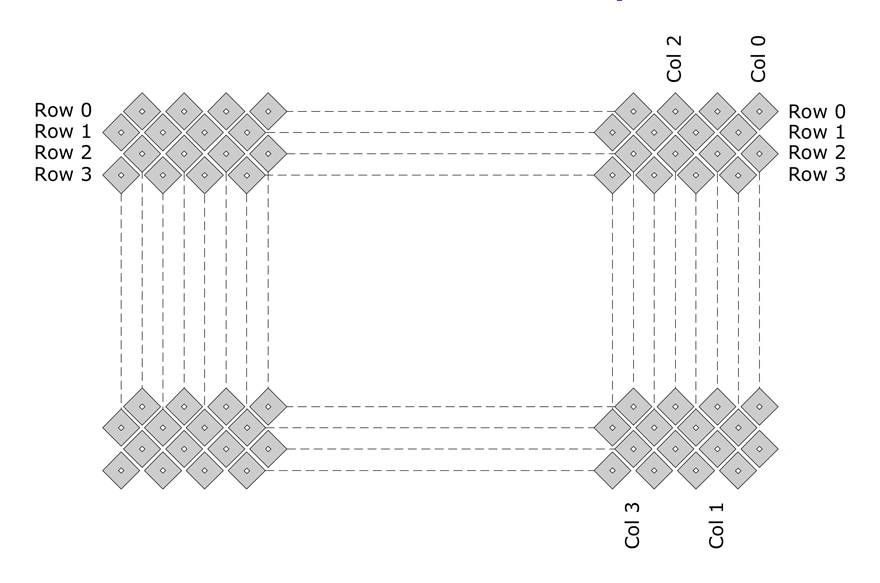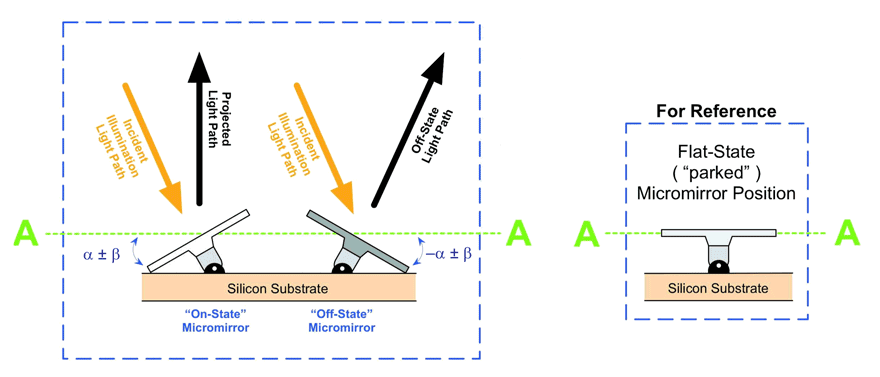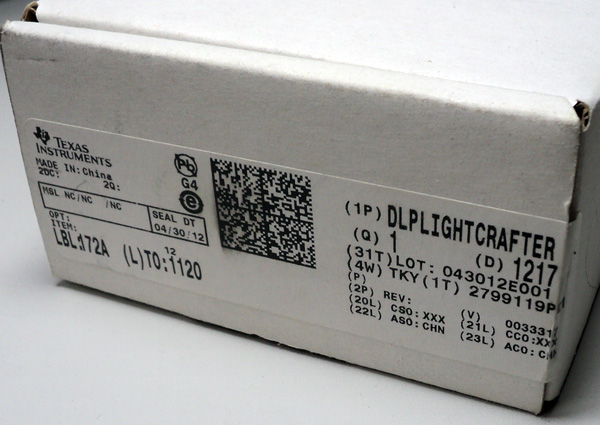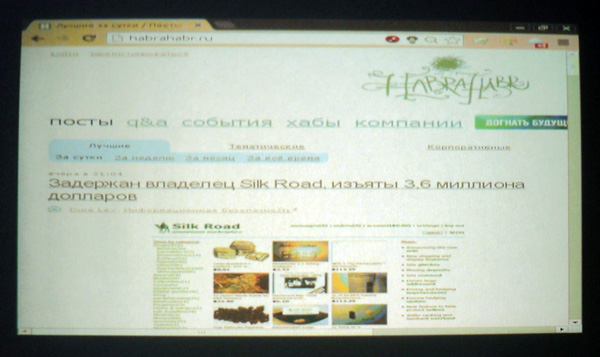Texas Instruments DLP LightCrafter Pico Projector Reference Design Review

On Habré already published several reviews of pico-projectors: Aiptek PocketCinema V60 and V100 , as well as SP-H03 from Samsung.
In this article we will talk about the platform that allows you to develop embedded devices with a projection module - this is the reference design of the DLP LightCrafter picprojector (DLP3000-C300REF) from Texas Instruments.
There are several technologies underlying modern pico-projectors: DLP (Digital Light Processing); LCoS (Liquid crystal on silicon) and LCD. We will not consider the last two. Let's tell a little more about the technology of DLP, which is used in our device.
')
The basis of the DLP is a digital micromirror device - DMD (Digital Micromirror Device) - a chip, on the surface of which there are several hundred thousand micromirrors, assembled into a single pixel array.

Each of the mirrors can deviate in both directions from its initial position at a small angle (10–12 degrees), thereby initiating the “on” and “off” states. Light incident on the mirror will be directed to the optics or to the side (usually the cooling system). To display a halftone, the mirror switches from "on" to "off" at high speed using pulse-width modulation.

Red, green and blue LEDs are used as emitters.
Contents of delivery
The device itself was in a small box. No cables and software, everything needs to be received separately, but with the Internet and standard cables, this is not a problem.

Inside was the following content:

- Trigger input / output
- Mini usb
- Power connector
- Mini HDMI
- UART
- Power connector
- I2C
- FPGA SPI Flash Programming Interface
- MSP430 / DLPC300 Flash Programming Interface
- On / off button
- Input Select Button (DM365 / Internal Test Pattern / HDMI)
- Ethernet PHY
- Fan Connector
- Camera
- Focus Management
- Boot mode switch
- Micro SD card
Technical features of the reference design DLP LightCrafter (DLP3000-C300REF):
- LED light RGB element (LED light engine), light stream 20 Lumen
- High scan rate when using the original resolution DLP3000 (608 x 684)
- Scan frequency up to 4000 Hz (binary image)
- Sweep frequency up to 120 Hz (8-bit gray scale)
- Demonstration of images and video in WVGA resolution (854 x 480)
- Customizable trigger input / output for synchronization with cameras, sensors, etc.
- Embedded DM365 processor running embedded Linux
- Memory NAND flash 128 MB
- Interfaces USB, Mini HDMI, UART
- USB API and host GUI
- Compact dimensions: 117 x 65 x 23 mm
The device is a "sandwich" of two boards on a metal base. An optical module with an emitter, connected to the boards with flexible cables, is installed nearby. The metal base also serves as a heat sink. The design is reliable and practical. All necessary connectors are located on the perimeter and on top. In principle, as it should be for development devices.
Schematic

An EVM module consists of a processor board, a driver board and a light emitter. The DM365 is a TMS320DM365 multimedia processor based on Texas Instruments DaVinci technology. It is used to run Embedded Linux. FPGA - Altera Cyclone IV FPGA, it controls the mixing of video channels (HDMI or DM365), controls the inclusion of LEDs and internal buffers for quick display of patterns. The DLPC300 is a DMD controller. MSP430 controls power and LED drivers.
Connection

- Power can be supplied directly from the computer's USB (but preferably from a separate power supply) by connecting to the connector on the lower DC_IN board.
- The debugging UART connects to the Minijack-2.5 connector, but because of its absence, we just soldered (red wires in a yellow pole).
- MiniUSB - standard wire.
- HDMI - via MiniHDMI / HDMI adapter.
Launch

To work with EVM, Texas Instruments provides a cross-platform graphical utility that displays images and video from the camera / HDMI, and also allows you to update the firmware.

There is also an example command line provided by the API.

Modes of operation
Internal patterns:

Static image:

HDMI video:

Build software (Linux + rootfs) for downloading from Micro-SD card
The manufacturer has taken care of the problem-free assembly and launch of software for your device. A normal BSP is proposed, allowing you to get workable binary images in a short time.
First you need to download and install Linux DVSDK by reference . But necessarily version 4.02, in which there is support for DM365. The manuals say that the host must be ubuntu 10.04. But we have easily transferred the installed SDK to ubuntu 12.04.
Further on the link you need to find DLP LightCrafter DM365 DVSDK (version 4.0), download and install. From the Changes subfolders with the installed files, you must copy the replacement files to the folder with the previously installed Linux DVSDK files.
The assembly is carried out with Sourcery toolchain for ARM from Mentor Graphics. Download and install it by the link . It is important to remember to add the path to the toolchain prefix to the $ PATH description.
The build is performed by a sequence of make, make all and make components commands. U-boot, uImage and rootfs images are compiled for use with an SD card.

To install all of this on the SD card, there is a ready-made script mksdboot_lcr.sh, it is located in the bin folder.

After completion of the script, you must insert the card into the slot and move the switch closer to the slot.
Download takes a little longer.

findings
A new platform for developing pico-projection devices from Texas Instruments called LightCrafter uses a digital light processor (DLP), built using MEMS technology with almost half a million micromirrors to form an image. RGB-LEDs are used as a light source, allowing to emit up to 20 lumen of light. And when using active cooling and a thermal management system, light of more than 50 lumens can be obtained, which allows using the LightCrafter in various conditions.
DLP LightCrafter can be used as a portable projector with HDMI input, as well as for the projection of structured light patterns, complex lighting with the ability to change the working wavelength (from ultraviolet to almost infrared light).
The ability to project structured light patterns allows you to use LightCrafter to instantly determine the characteristics and recognize 3D objects without touching them. The 3D scanning technology works by projecting a moving light strip onto objects and then analyzing the measurements of the deformation of the reflected band using the 3D shape restoration algorithm. This feature can be used in contactless fingerprint scanners to identify people. In addition to use for biometric, facial, dental and medical scans, DLP can be used in various applications: from industrial control systems to various scientific equipment. Through the use of additional FPGA, you can increase the frequency of output light patterns to 4000 per second.
To implement 3D scanning, an external camera and software that implements the appropriate 3D processing algorithm is required. Customizable platform shutter input / output allows you to synchronize the capture of frames by the camera (as well as other peripheral devices) with the projected frames of the light pattern.
Developers can create, store and display projected images using a software interface (API) via USB or an easy-to-use graphical user interface (GUI).
The powerful TMS320DM365 digital processor and Linux OS on the ARM core enable the development of a fully functional embedded system.
Thus, the use of pico-projector DLP LightCrafter in new developments allows to shorten the design cycle, to achieve a small form factor and to obtain a low cost price of the final equipment.
PS For other TI hardware solutions, see our website in the Texas Instrument Technologies for Electronics Design section.
Source: https://habr.com/ru/post/198560/
All Articles